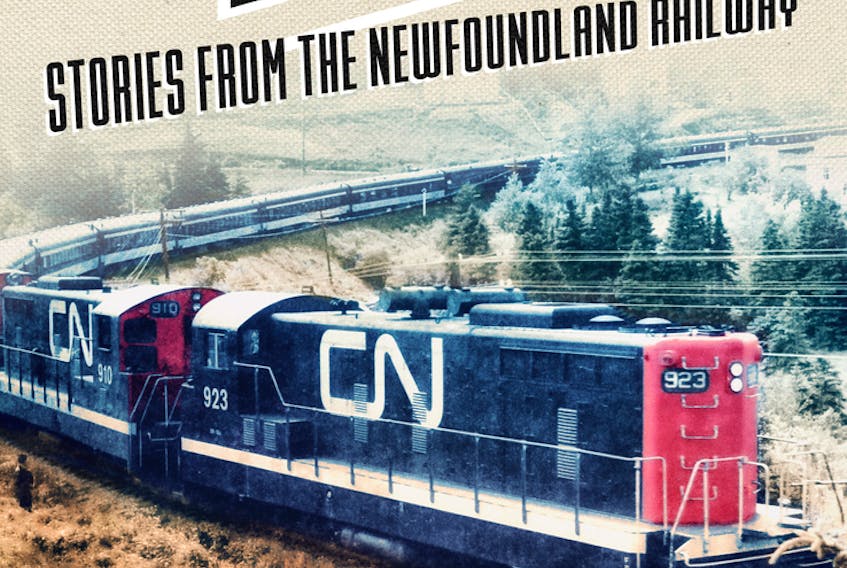Robert Hunt has previously published his “memoir trilogy” of “Corner Boys,” “Townies,” and “Brazil Street.” It’s rich stuff, first-hand stories peopled with memorable characters and formatting a very personal arc and timeframe.
Hunt also worked on the railway, starting out at 17 as a “pantry man.” His father, Edward, had started with CN on the coastal boat service (which is how he met his wife, Carmel Hayes, in Placentia Bay), and one of his older (of four) brothers joined CN too. He has long wanted to write about this, and here employs his own autobiography as well as family memorabilia alongside research at the Railway Coastal Museum and through the CN Pensioners Association. There are personal accounts, conversations he presents as per verbatim, archival documents, and details down to the rates of pay for conductors and brakemen, or the height, length, and weight of an engine. The book also includes black and white photos, and an Index.
Hunt takes this blended approach in the 20 chapters. Background information about the Reid Railway is wrapped around his family interactions with the train service
The Newfoundland Railway fits into N.L.’s collective memory and past in a way that straddles both history and folklore. The nickname, for instance: did it really come from the American soldiers, who declared it the slowest train they’d ever taken?
Hunt takes this blended approach in the 20 chapters. Background information about the Reid Railway is wrapped around his family interactions with the train service. His view of his father, for example: “In those days, the only other people who wore uniforms were military, firemen, or policemen. All of these men held jobs of influence and authority, so I reasoned my father had to be an important person.”
Speaking of significant Newfoundlanders, Tommy Ricketts, the VC-awarded Royal Newfoundland Regiment veteran, owned the pharmacy across from the railway station, and Hunt regularly conversed with him. In another intersection, Premier Joseph Smallwood was a frequent passenger. “When Joey travelled, it was like the second coming.”
He also notes that Hunt Sr. didn’t have a lot of time for the Premier; ironically, “and we never told him because of his dislike of the man, but he looked just like Mr. Smallwood.”
CN was, as Hunt would phrase it, a class act. The restaurant-worthy menu was matched with china and utensils set with the CN logo. Meals were served to people riding the train for family reunions, adventure, work, and medical consultations. The crews were often intimate with people’s reasons for their journey and became part of it. An aunt and niece making a final trip to an ailing grandmother left the train laden with extra treats and later had the full cost of their tickets refunded. They knew the children who made multiple trips to the Janeway, and followed both happy and dreaded outcomes. If they suspected a passenger was avoiding the dining car because they couldn’t afford a meal they would discreetly prepare something for them. They gave a guiding hand to some Romero-and-Juliet scenarios.

This despite their demanding shifts, setting out from St. John’s at 11 p.m. or 11:30 p.m,. up at 5 a.m. and working until the last dinner dish was washed, turning around at Port aux Basques and repeating the cycle, their to-do list reset when they passed the 50-mile marker outside of St. John’s. They were usually, but not always, on board for three days, starting on Tuesday, back on Friday, and then back on board on Monday (each rotation started the day before the previous one).
Until the drive was completed in ’65, the only way across the island was by train. Sometimes people must have fervently hoped for another. Here’s a tale from Jim Maddigan, who started as a call boy when the engines still ran on steam. “I remember one time being between Mile 75 and 77 in a snowstorm so severe that we spent nearly a week there in the high drifts that came close to covering the train. After several days, we ran out of food for the customers. We contacted local people in the area, who helped out with a large moose.”
There were also accidents, and tragedies, derailments, fires, wrecks, collisions.
Once, the body of a murder victim was discovered in a trunk.
Trains also got snarled up in political events like the IWA strike.
It was all part of the job. As Hunt quotes Len Penney, “The trains get into your blood, and there is something that stirs the imagination once you have grown up with or worked on them. You will always have an affinity for them.”
The Bullet made its last run in July, 1969.
Joan Sullivan is editor of Newfoundland Quarterly magazine. She reviews both fiction and non-fiction for The Telegram.









